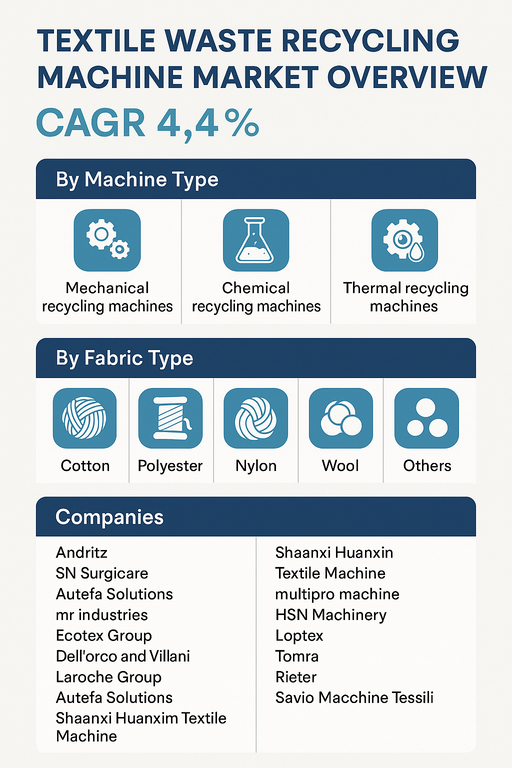The global textile waste recycling machine market is projected to expand at a CAGR of 4.4% from 2025 to 2033, fueled by the rising demand for sustainable textile practices, tightening environmental regulations, and growing public and industry awareness regarding circular economy principles. Recycling machines play a pivotal role in addressing the mounting textile waste crisis by enabling efficient recovery and reuse of fibers from pre-consumer and post-consumer waste, thereby reducing landfill use, water consumption, and carbon emissions across the value chain.

Growth in Sustainable Textile Manufacturing and Circular Economy Initiatives
The push for sustainable apparel and textile production is driving the adoption of recycling technologies that support fiber-to-fiber recovery and closed-loop systems. Governments and brands alike are implementing zero-waste mandates and take-back programs to reduce environmental impacts. As a result, textile recyclers are investing in advanced machinery capable of handling a wide variety of materials ranging from natural fibers to synthetics and blends with minimal degradation. Integration of automated sorting, pre-processing, and fiber refinement systems is boosting efficiency and scalability across recycling operations.
Challenges in Mixed Fabric Recycling and High Initial Investment
Despite market expansion, textile recycling machinery adoption is constrained by the complexity of handling mixed fabrics, the presence of non-recyclable blends, and high upfront costs. Chemical recycling machines, while capable of processing synthetic materials like polyester and nylon, often require significant energy input and sophisticated separation techniques. Additionally, smaller manufacturers and recyclers face barriers in capital investment, maintenance, and access to skilled labor. Limited infrastructure in developing regions also hinders large-scale deployment. However, ongoing R&D in hybrid recycling technologies and growing government subsidies for green industrial equipment are expected to ease these challenges over time.
Market Segmentation by Machine Type
The market is segmented into mechanical, chemical, and thermal recycling machines. In 2024, mechanical recycling machines dominated the global market due to their affordability, ease of operation, and ability to process a wide range of natural and synthetic textiles. These machines typically handle tasks such as tearing, opening, shredding, and carding to regenerate fiber for nonwoven applications or yarn production. Chemical recycling machines, although currently cost-intensive, are gaining traction for their ability to depolymerize materials such as PET and nylon into virgin-equivalent inputs. Thermal recycling machines, used for energy recovery and material sterilization, are applied selectively based on fabric composition and output requirements.
Market Segmentation by Fabric Type
By fabric type, the market includes cotton, polyester, nylon, wool, and others. In 2024, cotton held the largest market share due to its high volume in post-industrial and post-consumer textile waste streams, particularly in fast fashion and home furnishings. Mechanical recycling is predominantly used for cotton-based textiles. Polyester and nylon segments are expanding rapidly as chemical recycling technologies enable molecular regeneration, particularly in activewear and industrial textile waste. Wool recycling, traditionally practiced in Europe, is experiencing renewed demand in sustainable fashion. The others category includes mixed fabrics, viscose, acrylics, and elastane-containing materials, which require advanced sorting and processing techniques.
Regional Insights
In 2024, Asia Pacific led the textile waste recycling machine market, with China, India, and Bangladesh representing major textile-producing hubs focused on waste minimization and regulatory compliance. Europe followed, driven by aggressive sustainability mandates and producer responsibility regulations in countries such as Germany, Italy, and the Netherlands. North America showed strong interest in recycled textile products and infrastructure expansion, particularly in the U.S., where fashion brands and waste management players are forming strategic partnerships. Latin America and the Middle East & Africa are emerging markets where local textile industries are gradually investing in low-cost mechanical recycling solutions to manage growing waste volumes.
Competitive Landscape
The market in 2024 was characterized by a mix of multinational industrial machinery companies and regionally specialized equipment providers. Andritz, Rieter, and Autefa Solutions led the global market with comprehensive portfolios in nonwoven fiber recycling and carding machinery. Savio Macchine Tessili and Laroche Group provided specialized tearing and blending equipment tailored to recycled fibers. Tomra supported automated textile sorting solutions to improve feedstock quality. Dell'orco & Villani, Loptex, and Shaanxi Huanxin Textile Machine focused on scalable solutions for fiber extraction and pre-processing. Emerging companies such as mr industries, Ecotex Group, Multipro Machine, and HSN Machinery contributed innovative systems suited for regional textile mills and SME recyclers. Competitive differentiation is driven by fiber recovery efficiency, automation levels, machine throughput, and adaptability to diverse textile inputs.
Historical & Forecast Period
This study report represents analysis of each segment from 2023 to 2033 considering 2024 as the base year. Compounded Annual Growth Rate (CAGR) for each of the respective segments estimated for the forecast period of 2025 to 2033.
The current report comprises of quantitative market estimations for each micro market for every geographical region and qualitative market analysis such as micro and macro environment analysis, market trends, competitive intelligence, segment analysis, porters five force model, top winning strategies, top investment markets, emerging trends and technological analysis, case studies, strategic conclusions and recommendations and other key market insights.
Research Methodology
The complete research study was conducted in three phases, namely: secondary research, primary research, and expert panel review. key data point that enables the estimation of Textile Waste Recycling Machine market are as follows:
Market forecast was performed through proprietary software that analyzes various qualitative and quantitative factors. Growth rate and CAGR were estimated through intensive secondary and primary research. Data triangulation across various data points provides accuracy across various analyzed market segments in the report. Application of both top down and bottom-up approach for validation of market estimation assures logical, methodical and mathematical consistency of the quantitative data.
| ATTRIBUTE | DETAILS |
|---|---|
| Research Period | 2023-2033 |
| Base Year | 2024 |
| Forecast Period | 2025-2033 |
| Historical Year | 2023 |
| Unit | USD Million |
| Segmentation | |
Machine Type
| |
Fabric Type
| |
Operation
| |
Capacity
| |
Application
| |
Sourcing Type
| |
Distribution Channel
| |
|
Region Segment (2023-2033; US$ Million)
|
Key questions answered in this report